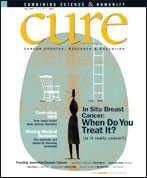Cure Becomes Less Risky
Allogeneic stem cell transplantation and improvements in conditioning treatments may make transplant available to more patients and lower risk of severe side effects.
About half of MDS patients are cured after allogeneic stem cell transplantation, a procedure where blood stem cells from a donor replace abnormal stem cells and produce the needed healthy blood cells. But serious side effects from the procedure and donor availability restrict many patients from taking this treatment route.
Side effects from the intense chemotherapy and/or total body radiation prior to transplant, known as conditioning treatment, may pose a problem, while the risk of graft-versus-host disease, where the new donor cells recognize the patient’s existing cells as foreign, creates a post-transplant problem. Stem cells nearly identical to the patient, whether from a sibling or matched unrelated donor, provide the best probability of success. Because matched donors are difficult to find—less than a quarter of patients eligible for a stem cell transplant have matched sibling donors—research continues for other methods.
Recent improvements in conditioning treatments may make transplant available to more patients. Using lower doses of chemotherapy or radiation, sometimes called a minitransplant, gives the opportunity for a transplant to older patients, who without treatment would have an average survival time of less than 18 months.
Stem cell transplant is used to treat people with intermediate-1, intermediate-2 and high-risk MDS. The age limit, previously 55, is reaching about 65—and even higher in select cases—because patients aren’t suffering problems previously encountered with the higher-intensity conventional transplants.
Worldwide databases have registered more than six million unmatched donors, and new techniques are allowing better matching between donor and patient and reducing mortality and the incidence of graft-versus-host disease.
